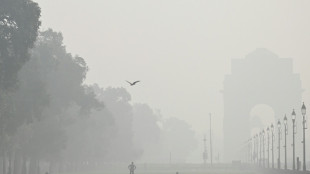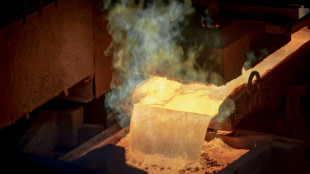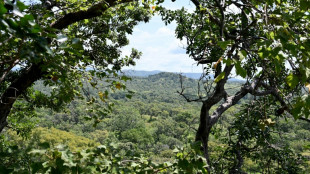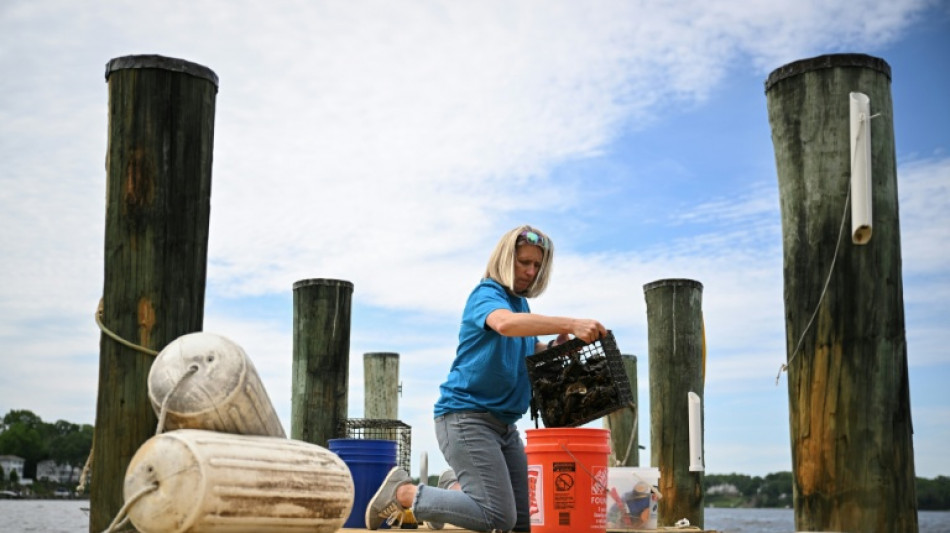
-
 India hails maiden women's World Cup cricket title as game-changer
India hails maiden women's World Cup cricket title as game-changer
-
As clock ticks down, Greece tries to clean up its act on waste
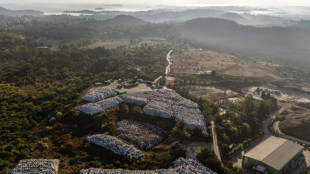
-
 Local fabrics, fibres shine at eco-centred Lagos Fashion Week
Local fabrics, fibres shine at eco-centred Lagos Fashion Week
-
Spalletti bidding to revive Juve and reputation ahead of Sporting visit in Champions League

-
 Tanzania president to be inaugurated as opposition says hundreds dead
Tanzania president to be inaugurated as opposition says hundreds dead
-
Bouanga brace as LAFC beats Austin 4-1 to advance in MLS Cup playoffs

-
 'Golden age': Japan hails Yamamoto, Ohtani after Dodgers triumph
'Golden age': Japan hails Yamamoto, Ohtani after Dodgers triumph
-
Thunder roll over Pelicans to remain NBA's lone unbeaten team

-
 Hong Kong legislature now an 'echo chamber', four years after shake-up
Hong Kong legislature now an 'echo chamber', four years after shake-up
-
Most Asian markets rise on lingering trader optimism

-
 Andrew to lose his last military rank: defence minister
Andrew to lose his last military rank: defence minister
-
Trump's global tariffs to face challenge before Supreme Court

-
 Barnstorming Bayern face acid test at reigning champions PSG
Barnstorming Bayern face acid test at reigning champions PSG
-
Alonso shaping new Real Madrid on Liverpool return

-
 Half Yours favourite at Australia's 'race that stops a nation'
Half Yours favourite at Australia's 'race that stops a nation'
-
Tonga rugby league star has surgery after 'seizure' against NZ

-
 Trent's return with Real Madrid reminds Liverpool of what they are missing
Trent's return with Real Madrid reminds Liverpool of what they are missing
-
Tehran toy museum brings old childhood memories to life
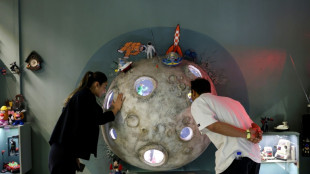
-
 Iran banking on Iraq vote to retain regional influence
Iran banking on Iraq vote to retain regional influence
-
Daughter of 'underground' pastor urges China for his release

-
 Trump the Great? President steps up power moves
Trump the Great? President steps up power moves
-
Fire ravages French monastery dubbed 'Notre-Dame of the Ardennes'

-
 Bills outlast Chiefs while NFL-best Colts fall to Steelers
Bills outlast Chiefs while NFL-best Colts fall to Steelers
-
NBA champion Thunder roll over Pelicans to remain unbeaten

-
 Eliud Kipchoge unveils plan to run 7 marathons on 7 continents
Eliud Kipchoge unveils plan to run 7 marathons on 7 continents
-
Milan deny Roma top spot in Serie A, Inter beat Verona

-
 Lens back up to third in Ligue 1 as Lyon held at Brest
Lens back up to third in Ligue 1 as Lyon held at Brest
-
NFL-best Colts fall to Steelers, Packers lose to Carolina

-
 'Regretting You' wins spooky slow N. American box office
'Regretting You' wins spooky slow N. American box office
-
'Just the beginning' as India lift first Women's World Cup

-
 Will Still sacked by struggling Southampton
Will Still sacked by struggling Southampton
-
Malinin wins Skate Canada crown with stunning free skate

-
 Barca beat Elche to recover from Clasico loss
Barca beat Elche to recover from Clasico loss
-
Jamaica deaths at 28 as Caribbean reels from colossal hurricane
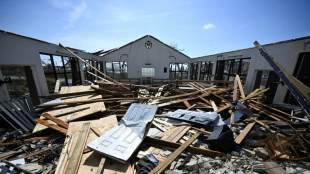
-
 Verma and Sharma power India to first Women's World Cup triumph
Verma and Sharma power India to first Women's World Cup triumph
-
Auger-Aliassime out of Metz Open despite not yet securing ATP Finals spot

-
 Haaland fires Man City up to second in Premier League
Haaland fires Man City up to second in Premier League
-
Sinner says staying world number one 'not only in my hands'

-
 Ready for it? Swifties swarm German museum to see Ophelia painting
Ready for it? Swifties swarm German museum to see Ophelia painting
-
Pope denounces violence in Sudan, renews call for ceasefire

-
 Kipruto, Obiri seal Kenyan double at New York Marathon
Kipruto, Obiri seal Kenyan double at New York Marathon
-
OPEC+ further hikes oil output

-
 Sinner returns to world number one with Paris Masters win
Sinner returns to world number one with Paris Masters win
-
Sinner wins Paris Masters, reclaims world No. 1 ranking

-
 Nuno celebrates first win as West Ham boss
Nuno celebrates first win as West Ham boss
-
Obiri powers to New York Marathon win

-
 Two Louvre heist suspects a couple with children: prosecutor
Two Louvre heist suspects a couple with children: prosecutor
-
Verma, Sharma help India post 298-7 in Women's World Cup final

-
 Inter snapping at Napoli's heels, Roma poised to pounce
Inter snapping at Napoli's heels, Roma poised to pounce
-
India space agency launches its heaviest satellite


US oyster gardeners rebuild nature's own water-cleaning system
For many just a tasty delicacy, the oyster may actually be the hero the world needs to fight environmental degradation -- and volunteers like Kimberly Price are battling to repopulate the surprisingly powerful species.
The 53-year-old is an "oyster gardener" who fosters thousands of the mollusks at her waterside home until they are old enough to be planted in the Chesapeake Bay near the US capital Washington, where they clean the water and can even offset climate change.
Far removed from the menus of seafood restaurants, oysters also have a supremely practical use as prolific water filters -- with an adult able to process up to 50 gallons (190 liters) each day.
This produces a healthier habitat, boosting plant and animal life, which experts say can also help waterways capture more planet-warming carbon dioxide.
But today, just one percent of the native oyster population found in the bay before the 1880s remains, due to pollution, disease and overharvesting -- leaving a mammoth task for environmentalists.
Volunteers like Price are crucial to these efforts led by the Chesapeake Bay Foundation (CBF).
For around nine months, they keep infant oysters in cages at their docks to give them the best chance of reaching adulthood. Then they put them to work at helping preserve the planet.
"We humans destroy everything, right? So this is like, let's fix our problems: how do we try and correct this?" Price, a housing consultant, told AFP.
At her Maryland home, where ospreys flew overhead and tiny fish swam below, she pulled up a mesh cage marked "Not for sale or human consumption" suspended by rope in the water.
Inside on large, old oyster shells -- many recycled from restaurants -- were half a dozen smaller live oysters each about the size of a knuckle.
When Price got them last summer, they were no bigger than pinpricks that the CBF had received as oyster larvae from a specialist hatchery before bonding them to shells in setting tanks.
Price's role has involved scrubbing her eight cages and rinsing them with fresh water every two weeks to remove organisms that can restrict oxygen and hinder feeding.
When AFP visited in late May, she was giving them a final clean before joining other volunteers returning the oysters to the CBF to be planted on sanctuary reefs in the bay, where fishing of the mollusks is banned.
- 'We can get there' -
It's part of an ambitious goal that the nonprofit and its partners set in 2018 to add 10 billion new oysters to the bay -- America's largest estuary -- by the end of 2025.
Around 6.7 billion have been planted so far, CBF oyster expert Kellie Fiala said at the group's headquarters, adding that the population is "trending in a positive direction."
"Thinking about how many oysters used to be in the bay, we still have a ways to go," she said, but insisted that "working together, we can get there."
A key challenge is a lack of substrate in the bay -- the hard riverbed material that oysters need to grow on -- because for many years, shells were removed to be used in building driveways and gardens.
"Folks then just didn't understand the importance of putting that shell back so it can be a home for new oysters," Fiala said.
To address this, the organization is encouraging volunteers to make "reef balls" -- igloo-style concrete blocks that can serve as artificial underwater habitats.
This initiative, like oyster gardening, encourages community participation ranging from schoolchildren to retirees.
Some of those volunteers, including Price, arrived at the CBF's office next to the bay to drop off their buckets of homegrown oysters ready for planting.
Each got a rough tally of how many they had brought based on the average number of babies on a handful of shells. For Price, it was what she celebrated as a "very good" total of around 7,500.
Her oysters were loaded with others onto a small, single-engine boat that the captain, 61-year-old Dan Johannes, steered towards a sanctuary reef in a tidal tributary of the bay.
There, two interns began dumping the 20 buckets overboard, with the oysters splashing into the water.
The planting process took no longer than a minute -- 75,000 oysters, raised for almost a year -- returning to the bay.
G.AbuHamad--SF-PST

